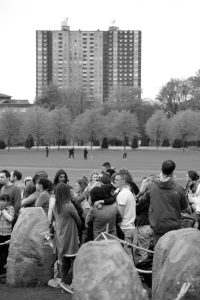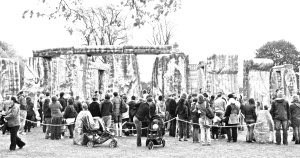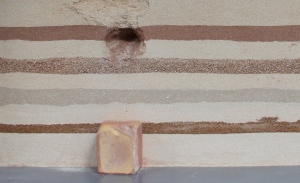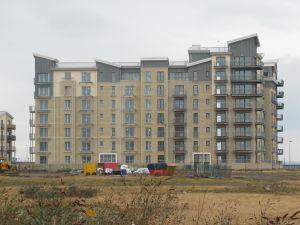Today (07/11/12) we made a visit to the original Maggie’s Centre, situated on the grounds of Edinburgh’s Western General hospital. Bult by Edinburgh-based Richard Murphy in 1994, in response to a brief provided by Maggie Jencks, it provides an informal drop-in centre for cancer sufferers, and their families, with therapeutic services, health advice, and a kitchen. Between us we knew three of the other Maggie’s: Glasgow, Kirkaldy and Dundee, and we talked to therapists who knew the rest. The architecture of the centres varies a good deal: this one a Victorian stable block as if built by Pippi Longstocking, Dundee (Frank Gehry) is a fairytale gingerbread house, Kircaldy (Zaha Hadid) a grounded stealth bomber. In the Edinburgh case, the starting point, the Victorian block, has been opened out at ground level with a mezzanine inserted above, leading to alcoves at each end. An eccentric, but well-stocked library fills the central stair. There’s a tropical fish tank, a very good selection of art from the Jencks collection on the walls, and some impeccable Scandinavian modern furniture. Playful, domestic, and low-key, it is a striking contrast to Wilson and Womersley’s adjoining chemotherapy unit (1968), a neo-medieval fortress compete with arrow slits, designed to look as sinister as possible.
We visited the Edinburgh Maggie’s as a therapeutic space. The design principles are simple and striking, as at all Maggies. THE DOOR. Here, as elsewhere, there’s no ceremony about the entrance, You just walk straight in to the main room, which because of all the glass at ground level is open to view from outside. They used to have a big wooden door, but got rid of it (‘intimidating’). Now it’s glass, like the rest of the adjoining wall. You’re outside, and then you’re in, with no waiting area or reception. The abruptness is slightly shocking, certainly by comparison with the surrounding hospital facilities which are as much facilities for waiting as they are for treatment. THE TABLE. The ground floor is open-plan, organised around a central kitchen. The key feature, here as elsewhere is a big table. It’s in some ways a old-fashioned device, suggestive of the semi-public realm of the country house kitchen, or (at the other end of the social scale) the factory canteen. More likely the former, thinking of Jencks. At any rate, it’s a means of allowing different modes of socialisation in the same place. It can be an extroverted, public, place, but as several staff told us, unprompted, it allows an introverted presence too. Some folks just sit there silently, just taking it in, thanking the others when they leave. Like any semi-public space, there are rights and responsibilities. You get given a cup of tea when you first go, then you have to make your own. THE ALCOVE. Unlike other therapeutic spaces you’re part of a public organisation from the start, with up to seventy visitors per day who by and large see each other and are positively encouraged to socialise. The are no consulting rooms, or even conventional rooms as such. Instead there are a range of alcoves or recesses which can – and usually are – closed with sliding doors during therapeutic sessions, which are, for the most part also scheduled.
A UTOPIAN SPACE. The centre does raise the intriguing possibility of a total therapeutic space, in which distinctions between clients and staff, public and private, work and non-work have been fully dissolved. In this utopian space, everyone, whoever they are, is both giving therapy and receiving it, in full public view, and the distinction between the therapeutic session (50 minutes) and the rest of ones life no longer makes any sense. There’s a curious shadow here of R. D. Laing’s Kingsley House experiment of 1965-70, in which Laing with a zeal that was becoming his trademark, set up a residential facility for schizophrenics and their clinical carers where professional distinctions were simply swept away. Maggie’s could not be more different in spirit, or aim. But it is a faintly utopian operation, redolent of possibilities beyond the immediate question of the care of cancer sufferers. From the perspective of therapy, it is staggeringly open. Most therapeutic spaces are fundamentally anti-social, designed in the belief that clients need to be kept apart from each other at all costs. Maggie’s is the opposite.
HAPPY BIRTHDAY. We visited on Maggie’s sixteenth birthday, a day of balloons and events. As we were leaving, a Tai-Chi class was underway in the largest space, while by the door, a singer with a guitar ran through a convincing rendition of Joni Mitchell’s ‘Big Yellow Taxi’. In this context of life-threatening, and often terminal illness, the line ‘you don’t know what you’ve got till it’s gone’ could have been excessively morbid. It wasn’t – in fact it seemed as cheerful as the architecture. If nothing else, that indicates just how different Maggie’s is compared to other kinds of therapeutic space.
For more on the Edinburgh Maggie’s Centre, and Maggie’s in general, go tohttp://www.maggiescentres.org/centres/edinburgh/introduction.html













